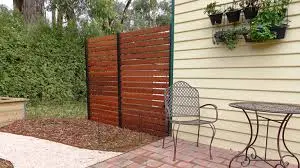Timber privacy screens are a beautiful and functional addition to any outdoor space, offering seclusion, enhancing the aesthetic appeal, and adding value to your property. However, building one can sometimes seem costly. But don’t worry—you can construct a stunning timber privacy screen without breaking the bank. In this guide, we’ll walk you through the process of building a budget-friendly timber privacy screen that doesn’t compromise on quality or style.
1. Planning and Design
Before you start, it’s essential to plan your project thoroughly. The planning phase will help you define your goals, estimate costs, and ensure that the final product meets your expectations.
- Determine the Purpose:
First, consider why you need a privacy screen. Is it to block the view from neighbours, create a sheltered outdoor area, or simply add a decorative element to your garden? Understanding the primary purpose will help you decide on the height, width, and design of your screen.
- Measure the Area:
Accurately measuring the area where you want to install the screen is crucial. This will help you determine the amount of material needed and avoid overbuying.
- Choose a Design:
There are various design options for timber privacy screens, from simple vertical slats to more intricate lattice patterns. For a budget-friendly project, consider opting for a straightforward design that requires fewer materials and is easier to construct.
2. Choosing the Right Timber
The type of timber you choose will significantly impact both the cost and durability of your privacy screen.
- Budget-Friendly Timber Options:
Pine and treated pine are excellent choices for budget-conscious builders. These types of wood are widely available, affordable, and relatively easy to work with. Treated pine, in particular, is resistant to rot and insect damage, making it suitable for outdoor use.
- Consider Recycled Timber:
For an even more cost-effective and eco-friendly option, consider using recycled timber. Many salvage yards offer reclaimed wood at a fraction of the cost of new timber. Recycled timber can add character to your privacy screen, with its weathered appearance and unique texture.
- Buy in Bulk:
If your project requires a significant amount of timber, buying in bulk can save you money. Many suppliers like Greenhill Timbers offer discounts for larger purchases, so consider teaming up with friends or neighbours who may also be working on projects.
3. Gathering Materials and Tools
Once you’ve chosen your timber, gather all the necessary materials and tools. Here’s a basic list:
- Timber (treated pine or recycled timber)
- Screws or nails
- Post-hole digger or shovel
- Concrete mix (optional for securing posts)
- Saw (circular or hand saw)
- Drill
- Measuring tape
- Spirit level
- Sandpaper
- Wood stain or paint (optional for finishing)
Tip: Rent Tools Instead of Buying
If you don’t own all the necessary tools, consider renting them from a local hardware store. This can be a cost-effective solution, especially for tools you may only use once.
4. Preparing the Site
Proper site preparation is key to ensuring your privacy screen is sturdy and long-lasting.
- Clear the Area:
Remove any debris, plants, or obstacles from the area where you plan to install the screen. Ensure the ground is level to make installation easier.
- Mark the Post Locations:
Using your measurements, mark where each post will go. Typically, posts should be spaced about 1.5 to 2 metres apart, depending on the design and the height of the screen.
- Dig the Post Holes:
Use a post-hole digger or shovel to dig holes for your posts. The holes should be deep enough to support the height of the screen—generally about one-third the height of the screen itself. For example, if your screen is 2 metres high, the post holes should be at least 60-70 centimetres deep.
5. Building the Privacy Screen
With your site prepared, you can now begin constructing your timber privacy screen. If you find any of the below processes hard doing yourself, Greenhill Timbers suppliers should be a call away.
- Install the Posts:
Place each post into the prepared hole, ensuring it is level and straight. You can use a spirit level to check this. If you’re in a windy area or want extra stability, consider setting the posts in concrete. Otherwise, firmly pack soil around the base of each post to secure it.
- Attach the Horizontal Rails:
Once your posts are in place, attach the horizontal rails that will support the vertical slats. These rails should be evenly spaced along the height of the screen—typically one at the top, one in the middle, and one at the bottom. Use screws or nails to secure the rails to the posts.
- Attach the Vertical Slats:
Now it’s time to attach the vertical slats. Start at one end and work your way across, ensuring each slat has even space. You can use a small piece of wood as a spacer to keep the gaps consistent. Attach each slat to the horizontal rails with screws or nails.
- Trim and Sand:
After all the slats are attached, trim any excess timber to ensure a neat, even edge along the top. Use sandpaper to smooth any rough edges or splinters.
6. Finishing Touches
While your timber privacy screen is now functional, adding a few finishing touches can enhance its appearance and longevity.
- Staining or Painting:
Applying a wood stain or paint can protect your timber from the elements and extend its lifespan. Stain highlights the natural beauty of the wood grain, while paint offers a wider range of colours to match your home’s exterior. Choose a weather-resistant product from Greenhill Timbers that are designed for outdoor use.
- Add Decorative Elements:
Consider adding decorative elements such as climbing plants, hanging lanterns, or outdoor art to personalise your screen. These additions can turn a simple privacy screen into a focal point in your garden.
- Maintain Your Screen:
Regular maintenance is essential to keep your timber privacy screen looking great for years to come. Inspect it annually for signs of wear, such as loose screws or nails, and reapply stain or paint as needed.
7. Cost-Saving Tips
Here are a few additional tips to help you build your timber privacy screen on a budget:
- Shop Around for Materials:
Prices for timber and other materials can vary widely between suppliers. Take the time to shop around and compare prices to get the best deals. Don’t forget to check for sales or discounts at local hardware stores.
- Reuse and Recycle:
If you have leftover timber or materials from other projects, consider using them for your privacy screen. You can also look for second-hand materials at salvage yards or online marketplaces.
- Keep It Simple:
The more complex the design, the more materials and time it will require. Stick to a simple, straightforward design to minimise costs.
- Involve Friends or Family:
If you’re not confident in your DIY skills, consider enlisting the help of friends or family members. Not only can they offer assistance, but it can also make the project more enjoyable.
Final Words
Building timber privacy screens on a budget is entirely achievable with careful planning, smart material choices, and a bit of DIY know-how. By following the steps outlined in this guide, you can create a beautiful, functional, and cost-effective privacy screen that enhances your outdoor space without straining your wallet.
Whether you choose to stain it for a natural look or paint it to match your home, your new timber privacy screen will provide privacy and style for years to come. Buy today from reliable suppliers like Greenhill Timbers for both local and imported quality.

